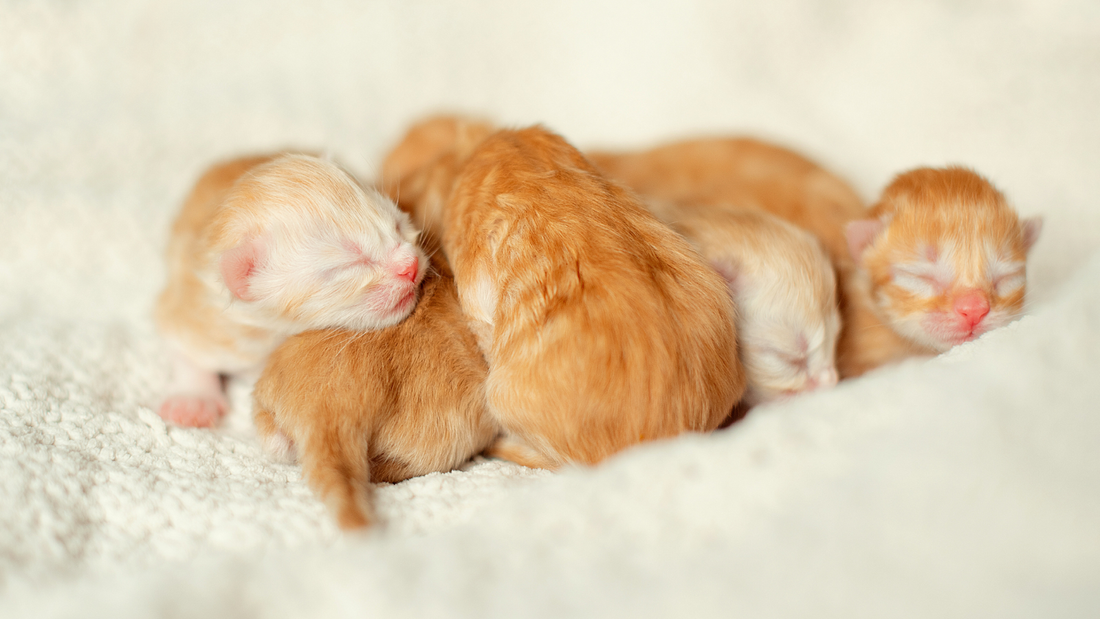Taking care of rejected kittens or an orphaned kitten is a special responsibility. They require regular, consistent feeding, even in the first weeks of their life. Kittens rely on their mother’s milk for nutrition to help them grow. However, if the mother is unavailable due to certain challenges, a kitten milk replacer can be effective in filling that void.
KMRs are known to mimic a mother’s natural milk, but there may be situations where you may not have immediate access to it. For that reason, you may be asking, “What can I use instead of kitten milk replacer?” The good news is that there are alternatives you can use, albeit temporarily, until you can find a commercial kitten milk replacer that will be useful for the long term.
Why Do Newborn Kittens Need Specialized Nutrition?
Newborn kittens tend to grow rapidly, meaning they require precise amounts of nutrients to support their growth entirely. Protein, fats, vitamins, and minerals can all be found in mother’s milk (colostrum) and serve an excellent purpose. Here’s a look at what they specifically do related to a kitten’s growth:
- High fat and protein are used for overall energy and muscle growth
- Calcium and phosphorus for bone development
- Essential fatty acids for developing brain and eye functions
- Immunoglobulins for disease protection
With the absence of mother’s milk, kitten milk replacers can be an effective alternative since they will typically contain most, if not all, of these essential nutrients for a kitten’s growth. Best of all, it’s easy to digest and is safe for kittens. It’s considered one of the best options compared to cow’s milk or human baby formulas, which can lack the nutrients that kittens need for growth. Plus, cow’s milk has the risk of creating digestive issues in kittens, such as bloating or diarrhea.
What Can Be Used As an Alternative to Kitten Milk Replacer?
There may be situations where kitten milk replacer is not immediately available or difficult to access. No hope is lost, as alternatives are available. Instead of figuring out what you can use as an alternative to kitten milk replacer, we provide you with some of the best options. Again, we would like to remind you that these are short-term options to rely on until you can purchase kitten formula or milk replacer. These are some of the emergency options to consider, including recipes:
Homemade Kitten Formula
If you are looking for a homemade recipe that some veterinarians highly recommend, this is one of them. Here’s how you can put it together for when you need an emergency solution for a kitten:
- 1 can of evaporated milk (make sure it’s unsweetened)
- 1 egg yolk (no egg whites)
- 2 tablespoons of plain yogurt (full fat, no artificial sweeteners)
- 1 teaspoon corn syrup (optional, but can be used for quick energy)
Mix the ingredients thoroughly. Using hot water, warm it up to around 100 degrees (F), which is the equivalent of their body temperature. When feeding, ensure you use a syringe or a specialized nursing bottle for small, frequent feedings. Position them on their stomachs and never feed them on their backs, as this can increase the risk of aspiration.
Feed kittens under a week old every 2 to 3 hours (even during the night). This can be an effective formula to utilize until you find a proper KMR that will be beneficial for kittens in the long term.
Goat’s Milk
You can use plain, unsweetened goat’s milk, which can be a useful short-term KMR alternative. What makes it stand out is that it has a similar protein structure compared to feline milk. If you’re wondering what you can use instead of kitten milk replacer, goat’s milk may be a good alternative. Despite this, it may not have the full nutrient profile that kittens need, which is why it’s another short-term alternative.
Remember, when feeding a kitten goat’s milk, the same concepts apply. Ensure it is warm to approximately 100 degrees (F) and feed them frequently. Once the opportunity arises, be sure to transition them to commercial KMR as soon as possible.
Kitten-Safe Commercial Liquid Goat Milk
Pet supply stores near you may have liquid goat milk formulas that are ready-to-serve. This may be a more effective option in the long term compared to homemade milk mixtures. They are safe for kittens and may be good to use if you don’t have KMRs immediately on hand.
Unflavored Pedialyte or Electrolyte Solution (Supportive Only)
If you have a kitten that is dehydrated or severely weak, there may be a situation where they are unable to nurse right away. However, don’t despair, as there is an excellent alternative. You can use unflavored Pedialyte or a safe electrolyte solution for pets. The purpose of this is to help provide kittens with adequate hydration while also stabilizing their blood sugar.
What to Avoid As a KMR Alternative?
For first-time caregivers, mistakes are often made on what to provide for kitten nutrition. Knowing what to avoid when KMR isn’t available can be crucial, especially to a kitten’s growth and overall health. Here are some of the alternatives that you will need to avoid:
- Cow’s Milk: Low fat content and protein, high in lactose. May cause digestive issues.
- Almond, Soy, or Oat Milk: These plant-based proteins are indigestible for kittens. At the same time, they may also lack essential nutrients.
- Human Baby Formula: Not formulated for kittens. Can lead to the risk of malnutrition.
- Sweetened Condensed Milk: Because of its high sugar content, it can be extremely dangerous for kittens.
- Coconut Milk: May lack essential nutrients despite being high in fat content.
These can also lead to side effects that range from mild to severe. They include bloating, diarrhea, nutrient deficiencies, diarrhea, and dehydration. Some of these can be life-threatening if unaddressed.
Feeding Tips for Emergency Alternatives
Now that you have a good idea of what to use (and not to use) for kitten milk replacer alternatives, there are some feeding tips you should follow. These best practices, when done correctly, can ensure your kitten is nourished properly and safely. Here’s what you can do:
- Warm the Formula: A kitten’s body temperature is approximately 100 degrees (F). Make sure the milk is always warm at this temperature. The best way to warm it is by using a bottle warmer or placing it in warm water. Never warm kitten formula in the microwave.
- Feed Small, Frequent Meals: If a newborn kitten is under 2 weeks old, they will need to be fed every 2 to 3 hours, including overnight. As they continue to grow, the feeding periods can be spaced further.
- Use Proper Equipment: Use either a kitten nursing bottle, syringe, or a feeding tube (with vet guidance only). The nipple hole needs to have a slow and steady drip. Make sure there is no fast feeding, as it can cause aspiration.
- Keep Them Clean: Wipe the kitten’s mouth clean and gently stimulate their genital area with a warm cloth afterwards. This will help encourage urination and defecation. This wiping mimics the grooming task done by the mother cat.
How Long Do Kittens Need Milk Replacer?
Milk replacers for kittens can be useful up until about the 4th or 5th week of age. Typically, around this time, they can transition to soft kitten food that can be mixed with the milk replacer itself. Weaning is typically complete by around weeks 6 to 8. As for when to feed them formula, it depends on their age. The following is the timing schedule based on a kitten’s age:
- 0-3 Weeks: 100% milk replacer
- 4-5 Weeks: Begin mixing milk replacer with soft food
- 6-8 Weeks: Weaning stage, gradually reduce milk replacer and mix with dry food
- 8+ Weeks: Solid food, no milk replacer necessary
When Should You Contact a Vet?
There may be a situation where immediate veterinary care is necessary for kittens. Contact them as soon as possible if you spot the following issues:
- Possible dehydration (including signs like sunken eyes, poor skin elasticity, etc.)
- They won’t eat or are too weak to nurse
- Persistent diarrhea or bloating
- You cannot source KMR within the first 24 to 48 hours of their life
- Unsure about what to feed and how often, or if they are refusing to eat
Veterinary care (even in an emergency vet clinic) can save a kitten’s life. They can also assist you on what to do when you are taking care of a kitten without the presence of their mother. If you follow the instructions carefully and correctly, the kitten will be able to thrive as it usually would.
Nurturing Kittens with Smart, Safe Alternatives
Kitten milk replacer alternatives can be created with just some of the ingredients in your kitchen. This is only necessary if you currently have no KMRs on hand. Don’t forget to consider commercial kitten milk replacement options once they are readily accessible and available. Be sure to follow the feeding schedule outlined above. As your kitten grows older, we invite you to explore what Under the Weather has to offer for a cat that can live a healthy life from its kitten years and beyond.




